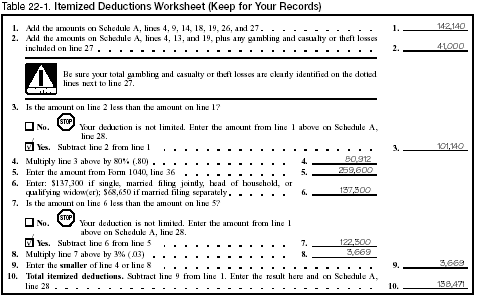22. Limit on Itemized Deductions
Introduction
This chapter discusses the overall limit on itemized deductions. The topics include:
- Who is subject to the limit,
- Which itemized deductions are limited, and
- How to figure the limit.
Useful Items
You may want to see:
Form (and Instructions)
- Schedule A (Form 1040) Itemized Deductions
Are You Subject
to the Limit?
You are subject to the limit on certain itemized deductions if your adjusted gross
income (AGI) is more than $137,300 ($68,650 if you are married filing separately). Your
AGI is the amount on line 36 of your Form 1040.
This limit does not apply to estates or trusts.
Which Itemized Deductions
Are Limited?
The following Schedule A (Form 1040) deductions are subject to the overall limit on
itemized deductions.
- Taxes - line 9.
- Interest - lines 10, 11, and 12.
- Gifts to charity - line 18.
- Job expenses and most other miscellaneous deductions - line 26.
- Other miscellaneous deductions - line 27, excluding gambling and casualty or theft
losses.
Which Itemized Deductions
Are Not Limited?
The following Schedule A (Form 1040) deductions are not subject to the overall limit on
itemized deductions. However, they are still subject to other applicable limits.
- Medical and dental expenses - line 4.
- Investment interest expense - line 13.
- Casualty and theft losses from personal use property - line 19.
- Casualty and theft losses from income-producing property - line 27.
- Gambling losses - line 27.
How Do You Figure
the Limit?
If your itemized deductions are subject to the limit, the total of all your itemized
deductions is reduced by the smaller of:
- 3% of the amount by which your AGI exceeds $137,300 ($68,650 if married filing
separately), or
- 80% of your itemized deductions that are affected by the limit. See Which Itemized
Deductions Are Limited, earlier.
Before you figure the overall limit on itemized deductions, you must first complete
lines 1 through 27 of Schedule A (Form 1040), including any appropriate forms (such as
Form 2106, Form 4684, etc.).
The overall limit on itemized deductions is figured after you have applied any other
limit on the allowance of any itemized deduction. These other limits include charitable
contribution limits (chapter 26), the limit on certain meals and entertainment (chapter
28), and the 2%-of- adjusted-gross-income limit on certain miscellaneous deductions
(chapter 30).
Itemized Deductions Worksheet. After you have completed Schedule A
(Form 1040) through line 27, you can use the Itemized Deductions Worksheet in the
Form 1040 instructions for Schedule A to figure your limit. Enter the result on line 28 of
Schedule A. Keep the worksheet for your records.

Itemized Deduction Worksheet
 You should
compare the amount of your standard deduction to the amount of your itemized deductions
after applying the limit. Use the greater amount when completing line 38 of your Form
1040. See chapter 21 for information on how to figure your standard deduction. You should
compare the amount of your standard deduction to the amount of your itemized deductions
after applying the limit. Use the greater amount when completing line 38 of your Form
1040. See chapter 21 for information on how to figure your standard deduction.
Example
For tax year 2002, Bill and Terry Willow are filing a joint return on Form 1040. Their
adjusted gross income is $259,600. Their Schedule A itemized deductions are as follows:
| Taxes - line 9 |
|
$ 17,900 |
| Interest - lines 10, 11, and 12 |
|
45,000 |
| Investment interest expense - line 13 |
|
41,000 |
| Gifts to charity - line 18 |
|
21,000 |
| Job expenses - line 26 |
|
17,240 |
| Total |
|
$142,140 |
The Willows' investment interest expense deduction ($41,000 from line 13 of Schedule A)
is not subject to the overall limit on itemized deductions.
The Willows use the Itemized Deductions Worksheet in the Form 1040
instructions for Schedule A to figure their overall limit. Their completed worksheet is
shown as Table 22-1.
Of their $142,140 total itemized deductions, the Willows can deduct only $138,471
($142,140 - $3,669). They enter $138,471 on Schedule A, line 28.
- Continue - |